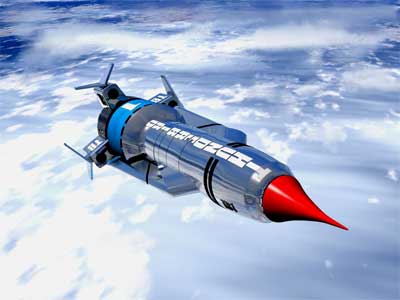

Straight out of the freakin' Thunderbirds!
Posted on 08/19/2014 12:25:27 PM PDT by BenLurkin
Engine technology being developed for a British space plane could also find its way into hypersonic aircraft built by the U.S. military.
The U.S. Air Force Research Laboratory is studying hypersonic vehicles that would use the Synergetic Air-Breathing Rocket Engine (SABRE), which the English company Reaction Engines Ltd. is working on to power the Skylon space plane, AFRL officials said.
"AFRL is formulating plans to look at advanced vehicle concepts based on Reaction Engine's heat-exchanger technology and SABRE engine concept," officials with AFRL, which is based in Ohio, told Space.com via email last month.
...
SABRE burns hydrogen and oxygen. It acts like a jet engine in Earth's thick lower atmosphere, taking in oxygen to combust with onboard liquid hydrogen. When SABRE reaches an altitude of 16 miles (26 kilometers) and five times the speed of sound (Mach 5), however, it switches over to Skylon's onboard liquid oxygen tank to reach orbit. (Hypersonic flight is generally defined as anything that reaches at least Mach 5.)
Two SABREs will power the Skylon space plane — a privately funded, single-stage-to-orbit concept vehicle t-hat is 276 feet (84 meters) long. At takeoff, the plane will weigh about 303 tons (275,000 kilograms).
(Excerpt) Read more at space.com ...
Makes sense to carry less oxygen because until it is burned, it is nothing but dead weight.
Why not takeoff with the hydrogen tank partially filled and the oxygen tank empty, and then fill both tanks via aerial refueling. That should allow for much greater payload to orbit. It probably would require some new tanker technology to handle the low temperature liquids. Even just filling the LOX tank and not the much colder liquid hydrogen tank (should that prove to be too difficult) in the air would give you much better mass to orbit performance.


Straight out of the freakin' Thunderbirds!
This was an interesting article. I understand researching alternate approaches to a problem but twenty years ago we used the heat of hypersonic to turn a liquid (fuel) into a gas. Now we’re going to go 180 degrees out after twenty years and turn a gas (oxygen) into a liquid. The guy’s funny quote was “we don’t want to reinvent the wheel” The original intent was to develop an air-breather, this seems more rocket than plane. Twenty years ago I saw a co-op get his PhD and take over a major facility, guess he’s about ready for his government retirement now, haha, and we still don’t have a plane in the air.
Since the tanker would necessarily fly at a much lower speed and lower altitude, I can’t see the advantage of developing the complex technology involved in mid air LOX and liquid hydrogen transfer.
As a comparison, the Space Shuttle burned nearly a fifth of its LH2 and LOX in order to reach 35,000 feet, and that is with the assist of two solid rock boosters.
“When SABRE reaches an altitude of 16 miles (26 kilometers) and five times the speed of sound (Mach 5), however, it switches over to Skylon’s onboard liquid oxygen tank to reach orbit. (Hypersonic flight is generally defined as anything that reaches at least Mach 5.)”
I don’t see how you can scrub the oxygen from the inlet air to produce the liquid oxygen and ever achieve mach 5 to begin with. Either this way or the “old” way a combined cycle engine is necessary. Hydrogen wasn’t the only fuel researched that made the “old” way (full air-breather) feasible.
Disclaimer: Opinions posted on Free Republic are those of the individual posters and do not necessarily represent the opinion of Free Republic or its management. All materials posted herein are protected by copyright law and the exemption for fair use of copyrighted works.